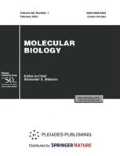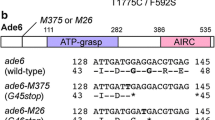Abstract
Previously, we described and characterized the yeast nonchromosomal determinant [NSI +], which possesses prion properties. This determinant causes a decrease in fidelity of translation termination, which is phenotypically detectable as the nonsense suppression in the strains with decreased functional activity of eRF3 release factor. As a result of the genetic screen, we demonstrated that an increase in the expression of SUP45 that encodes the eRF1 release factor (Sup45), masks, but does not eliminate nonsense suppression in the [NSI +] strains. In the present study, we first demonstrated the direct cause for the nonsense suppression in [NSI +] strains. We demonstrated that [NSI +] decreases the relative amounts of SUP45 mRNA, which causes a decrease in the amounts of Sup45 protein that can be detected in the stationary growth phase. The data obtained suggest the structural protein of [NSI +] seems to be either a transcription factor or participates in the regulation of cellular mRNA stability.
Similar content being viewed by others
References
Wickner R.B. 1994. [URE3] as an altered URE2 protein: Evidence for a prion analog in Saccharomyces cerevisiae. Science. 264, 566–569.
Derkatch I.L., Bradley M.E., Hong J.Y., Liebman S.W. 2001. Prions affect the appearance of other prions: The story of [PIN]. Cell. 106, 171–182.
Derkatch I.L., Bradley M.E., Zhou P., Chernoff Y.O., Liebman S.W. 1997. Genetic and environmental factors affecting the de novo appearance of the [PSI +] prion in Saccharomyces cerevisiae. Genetics. 147, 507–519.
Du Z., Park K.W., Yu H., Fan Q., Li L. 2008. Newly identified prion linked to the chromatin-remodeling factor Swi1 in Saccharomyces cerevisiae. Nature Genet. 40, 460–465.
Alberti S., Halfmann R., King O., Kapila A., Lindquist S. 2009. A systematic survey identifies prions and illuminates sequence features of prionogenic proteins. Cell. 137, 146–158.
Patel B.K., Liebman S.W. 2007. “Prion-proof” for [PIN +]: Infection with in vitro-made amyloid aggregates of Rnq1p-(132–405) induces [PIN+]. J. Mol. Biol. 365, 773–782.
Rogoza T., Goginashvili A., Rodionova S., Ivanov M., Viktorovskaya O., Rubel A., Volkov K., Mironova L. 2010. Non-Mendelian determinant [ISP +] in yeast is a nuclear-residing prion form of the global transcriptional regulator Sfp1. Proc. Natl. Acad. Sci. U. S. A. 107, 10573–10577.
Halfmann R., Wright J.R., Alberti S., Lindquist S., Rexach M. 2012. Prion formation by a yeast GLFG nucleoporin. Prion. 6, 391–399.
Suzuki G., Shimazu N., Tanaka M. 2012. A yeast prion, Mod5, promotes acquired drug resistance and cell survival under environmental stress. Science. 336, 355–359.
Osherovich L.Z., Weissman J.S. 2001. Multiple Gln/Asn-rich prion domains confer susceptibility to induction of the yeast [PSI +] prion. Cell. 106, 183–194.
Roberts B.T., Wickner R.B. 2003. Heritable activity: A prion that propagates by covalent autoactivation. Genes Dev. 17, 2083–2087.
Brown J.C., Lindquist S. 2009. A heritable switch in carbon source utilization driven by an unusual yeast prion. Genes Dev. 23, 2320–2332.
Yang W., Yang H., Tien P. 2006. In vitro self-propagation of recombinant PrPSc-like conformation generated in the yeast cytoplasm. FEBS Lett. 580, 4231–4235.
Serio T.R., Cashikar A.G., Kowal A., Sawicki G.J., Moslehi J.J., Serpell L., Arnsdorf M.F., Lindquist S.L. 2000. Nucleated conformational conversion and the replication of conformational information by a prion determinant. Science. 289, 1317–1321.
Saifitdinova A.F., Nizhnikov A.A., Lada A.G., Rubel A.A., Magomedova Z.M., Ignatova V.V., Inge-Vechtomov S.G., Galkin A.P. 2010. [NSI +]: A novel non-Mendelian suppressor determinant in Saccharomyces cerevisiae. Curr. Genet. 56, 467–478.
Nizhnikov A.A., Magomedova Z.M., Rubel A.A., Kondrashkina A.M., Inge-Vechtomov S.G., Galkin A.P. 2012. [NSI +] determinant has a pleiotropic phenotypic manifestation that is modulated by SUP35, SUP45, and VTS1 genes. Curr. Genet. 58, 35–47.
Zhouravleva G., Frolova L., Le Goff X., Le Guellec R., Inge-Vechtomov S., Kisselev L., Philippe M.1995. Termination of translation in eukaryotes is governed by two interacting polypeptide chain release factors, eRF1 and eRF3. EMBO J. 14, 4065–4072.
Kaiser C., Michaelis S., Mitchell A. 1994. Methods in Yeast Genetics. Cold Spring Harbor, NY: Cold Spring Harbor Lab. Press.
Hanahan D. 1985. DNA Cloning: A Practical Approach. IRL Press.
Sambrook J., Fritsch E.F., Maniatis T. 1989. Molecular Cloning. A Laboratory Manual. Cold Spring Harbor, NY: Cold Spring Harbor Lab. Press.
Zakharov I.A., Kozhin S.A., Kozhina T.N., Fedorova I.V. 1984. Sbornik metodik po genetike drozhzhei-sakharomitsetov (Methods in Saccharomyces Yeast Genetics), Leningrad: Nauka.
Sherman F., Fink G.R., Hancks J.B. 1986. Methods in Yeast Genetics. Cold Spring Harbor, NY: Cold Spring Harbor Lab. Press.
Livak K., Schmittgen T. 2001. Analysis of relative gene expression data using real-time quantitative PCR and the 2-DDCT method. Methods. 25, 402–408.
Newnam G.P., Wegrzyn R.D., Lindquist S.L., Chernoff Y.O. 1999. Antagonistic interactions between yeast chaperones Hsp104 and Hsp70 in prion curing. Mol. Cell. Biol. 19, 1325–1333.
Bradford M.M. 1976. Rapid and sensitive method for the quantitation of microgram quantities of protein utilizing the principle of protein-dye binding. Anal. Biochem. 72, 248–254.
Kiktev D., Moskalenko S., Murina O., Baudin-Baillieu A., Rousset J.P., Zhouravleva G. 2009. The paradox of viable sup45 STOP mutations: A necessary equilibrium between translational readthrough, activity and stability of the protein. Mol. Genet. Genom. 282, 83–96.
Inge-Vechtomov S.G. 1964. Back mutations to prototrophism in adenine-dependent yeasts. Vestn. Leningr. Gos. Univ. 9, 112–117.
Ivanov M.S., Radchenko E.A., Mironova L.N. 2010. The protein complex Ppz1p/Hal3p and nonsense suppression efficiency in the yeast Saccharomyces cerevisiae. Mol. Biol. (Moscow). 44, 907–914.
Nizhnikov A.A., Kondrashkina A.M., Antonets K.S., Galkin A.P. 2014. Overexpression of genes encoding asparagine-glutamine-rich transcriptional factors causes nonsense suppression in Saccharomyces cerevisiae. Russian Journal of Genetics: Applied Research. 4, 122–130.
Nizhnikov A.A., Magomedova Z.M., Saifitdinova A.F., Inge-Vechtomov S.G., Galkin A.P. 2012. Identification of genes encoding potentially amyloidogenic proteins that take part in the regulation of nonsense suppression in yeast Saccharomyces cerevisiae. Russ. J. Genet.: Applied Res. 2, 399–405.
Nizhnikov A.A., Magomedova Z.M., Saifitdinova A.F., Inge-Vechtomov S.G., Galkin A.P. 2011. Identification of genes encoding potentially amyloidogenic proteins involved in regulation of nonsense suppression in yeast Saccharomyces cerevisiae. Ekol. Genet. 9, 79–86.
Cox B.S. 1965. Psi, a cytoplasmic supperssor of supersuppressors in yeast. Heredity. 20, 505–521.
Radchenko E., Rogoza T., Khokhrina M., Drozdova P., Mironova L. 2011. SUP35 expression is enhanced in yeast containing [ISP +], a prion form of the transcriptional regulator Sfp1. Prion. 5, 317–322.
Nizhnikov A.A., Kondrashkina A.M., Galkin A.P. 2013. Interactions of [NSI +] prion-like determinant with SUP35 and VTS1 genes in Saccharomyces cerevisiae. Russ. J. Genet. 49, 1004–1012.
Ono B., Yoshida R., Kamiya K., Sugimoto T. 2005. Suppression of termination mutations caused by defects of the NMD machinery in Saccharomyces cerevisiae. Genes Genet. Syst. 80, 311–316.
Author information
Authors and Affiliations
Corresponding author
Additional information
Original Russian Text © A.M. Kondrashkina, K.S. Antonets, A.P. Galkin, A.A. Nizhnikov, 2014, published in Molekulyarnaya Biologiya, 2014, Vol. 48, No. 5, pp. 790–796.
Rights and permissions
About this article
Cite this article
Kondrashkina, A.M., Antonets, K.S., Galkin, A.P. et al. Prion-like determinant [NSI +] decreases the expression of the SUP45 gene in Saccharomyces cerevisiae . Mol Biol 48, 688–693 (2014). https://doi.org/10.1134/S0026893314050069
Received:
Accepted:
Published:
Issue Date:
DOI: https://doi.org/10.1134/S0026893314050069



